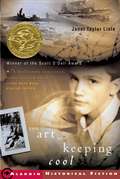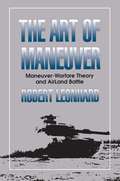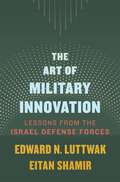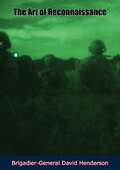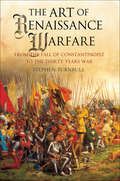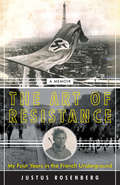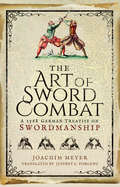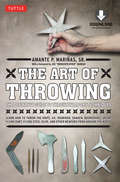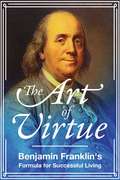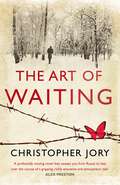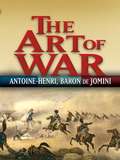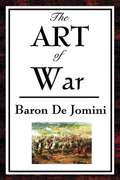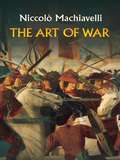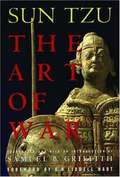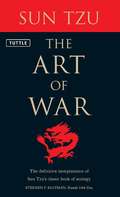- Table View
- List View
The Art of Intelligence: Lessons from a Life in the CIA's Clandestine Service
by Henry A. CrumptonA legendary CIA spy and counterterrorism expert tells the spellbinding story of his high-risk, action-packed career while illustrating the growing importance of America's intelligence officers and their secret missions. For a crucial period, Henry Crumpton led the CIA's global covert operations against America's terrorist enemies, including al Qaeda. In the days after 9/11, the CIA tasked Crumpton to organize and lead the Afghanistan campaign. With Crumpton's strategic initiative and bold leadership, from the battlefield to the Oval Office, U.S. and Afghan allies routed al Qaeda and the Taliban in less than ninety days after the Twin Towers fell. At the height of combat against the Taliban in late 2001, there were fewer than five hundred Americans on the ground in Afghanistan, a dynamic blend of CIA and Special Forces. The campaign changed the way America wages war. This book will change the way America views the CIA. The Art of Intelligence draws from the full arc of Crumpton's espionage and covert action exploits to explain what America's spies do and why their service is more valuable than ever. From his early years in Africa, where he recruited and ran sources, from loathsome criminals to heroic warriors; to his liaison assignment at the FBI, the CIA's Counterterrorism Center, the development of the UAV Predator program, and the Afghanistan war; to his later work running all CIA clandestine operations inside the United States, he employs enthralling storytelling to teach important lessons about national security, but also about duty, honor, and love of country. No book like The Art of Intelligence has ever been written--not with Crumpton's unique perspective, in a time when America faced such grave and uncertain risk. It is an epic, sure to be a classic in the annals of espionage and war.
The Art of Intelligence: Lessons from a Life in the CIA's Clandestine Service
by Henry A. CrumptonA legendary CIA spy and counterterrorism expert tells the spellbinding story of his high-risk, action-packed career while illustrating the growing importance of America's intelligence officers and their secret missions For a crucial period, Henry Crumpton led the CIA's global covert operations against America's terrorist enemies, including al Qaeda. In the days after 9/11, the CIA tasked Crumpton to organize and lead the Afghanistan campaign. With Crumpton's strategic initiative and bold leadership, from the battlefield to the Oval Office, U. S. and Afghan allies routed al Qaeda and the Taliban in less than ninety days after the Twin Towers fell. At the height of combat against the Taliban in late 2001, there were fewer than five hundred Americans on the ground in Afghanistan, a dynamic blend of CIA and Special Forces. The campaign changed the way America wages war. This book will change the way America views the CIA. The Art of Intelligence draws from the full arc of Crumpton's espionage and covert action exploits to explain what America's spies do and why their service is more valuable than ever. From his early years in Africa, where he recruited and ran sources, from loathsome criminals to heroic warriors; to his liaison assignment at the FBI, the CIA's Counterterrorism Center, the development of the UAV Predator program, and the Afghanistan war; to his later work running all CIA clandestine operations inside the United States, he employs enthralling storytelling to teach important lessons about national security, but also about duty, honor, and love of country. No book like The Art of Intelligence has ever been written-not with Crumpton's unique perspective, in a time when America faced such grave and uncertain risk. It is an epic, sure to be a classic in the annals of espionage and war.
The Art of Keeping Cool
by Janet Taylor LisleThe War At Home Fear permeates the Rhode Island coastal town where Robert, his mother, and sister are living out the war with his paternal grandparents: Fear of Nazi submarines offshore. Fear of Abel Hoffman, a German artist living outside of town.
The Art of Keeping Cool
by Janet Taylor Lisle<P>Fear permeates the Rhode Island coastal town where Robert, his mother, and sister are living out the war with his paternal grandparents: Fear of Nazi submarines offshore. Fear of Abel Hoffman, a German artist living reclusively outside of town. And for Robert, a more personal fear, of his hot-tempered, controlling grandfather. <P>As Robert watches the townspeople's hostility toward Hoffman build, he worries about his sensitive cousin Elliot's friendship with the artist. And he wonders more and more about the family secret everyone seems to be keeping from him -- a secret involving Robert's father, a bomber pilot in Europe. <P>Will Elliot's ability to detach himself from the turmoil around him be enough to sustain him when prejudice and suspicions erupt into violence? And can Robert find his own way to deal with the shocking truth about his family's past? <P><b> Winner of the Scott O'Dell Award for Historical Fiction </b>
The Art of Longsword Fighting: Teaching the Foundations of Sigmund Ringeck's Style
by Benjamin J. SmithThe teaching of Historical European Martial Arts has widespread appeal with numerous clubs in many countries. However, comparatively few people who run their own club have qualifications that would make them an instructor in traditional martial arts organizations. Even those with such qualifications lack in-depth cohesive resources for teaching a given style – often because they can only work from incomplete sources. Thus, the need for a book which is grounded in exhaustive research into historical teaching methods and in particular focusing on the specific style of Sigmund Ringeck, who was himself a teacher of fighting arts in the late 14th century or the early or mid-15th century. In The Art of Longsword Fighting, Benjamin J. Smith therefore offers the broader information necessary for teachers of historical swordsmanship to deliver courses based on original, authentic techniques. This includes the various cutting methods, the role of competition in learning these arts, the mechanics of the interpretive process, and insights into how to use a wide range of activities to enhance students’ experience. All of this is achieved through a panoply of photographs showing each move along with explanatory diagrams as well as detailing how and when to introduce each next step in a manner that is faithful to Ringeck’s style. There is no current literature available which demonstrates how each move should be undertaken and, most importantly, why each step should be taken in the sequences described. There is no doubt that a book of this nature has been long awaited and will be welcomed by instructors and students alike as well as those general readers interested in fencing and the longsword of the Renaissance period.
The Art of Maneuver: Maneuver-Warfare Theory and AirLand Battle
by Robert R. LeonhardLeonhard exposes as folly our view of war as an attritional phenomenon, measuring success in body counts and tons of explosives spent.
The Art of Military Deception
by Mark LloydThis in-depth analysis of military deception examines tactics employed across centuries and continents, from ancient times to WWII. The art of military deception is as old as warfare itself. It has been a vital part of virtually every successful campaign ever recorded, and yet has been largely overlooked in the annals of military history. In The Art of Military Deception, Mark Lloyd corrects this oversight with a wide-ranging analysis of strategies and tactics through the ages. Lloyd treats this much-neglected aspect of warfare thematically rather than chronologically covering such topics as disinformation campaigns, lies on the home front, and psychological warfare. He draws on a wide range of examples to show the elaborate techniques which have been employed in the struggle to outwit the enemy. Particularly fascinating is his analysis of the fatal error of self-deception.
The Art of Military Innovation: Lessons From The Israel Defense Forces
by Edward N. Luttwak Eitan ShamirA world-leading military strategist and an IDF insider explain the improbable success of the Israeli armed forces.When the Israel Defense Forces was established in May 1948, it was small, poorly equipped, and already at war. Lacking sufficient weaponry or the domestic industrial base to produce it, the newborn military was forced to make do with whatever it could get its hands on. That spirit of improvisation carried the IDF to a decisive victory in the First Arab-Israeli War.Today the same spirit has made the IDF the most powerful military in the Middle East and among the most capable in the world. In The Art of Military Innovation, Edward N. Luttwak and Eitan Shamir trace the roots of this astounding success. What sets the IDF apart, they argue, is its singular organizational structure. From its inception, it has been the world’s only one-service military, encompassing air, naval, and land forces in a single institutional body. This unique structure, coupled with a young officer corps, allows for initiative from below. The result is a nimble organization inclined toward change rather than beholden to tradition.The IDF has fostered some of the most significant advances in military technology of the past seventy years, from the first wartime use of drones to the famed Iron Dome missile defense system, and now the first laser weapon, Iron Beam. Less-heralded innovations in training, logistics, and human resources have been equally important. Sharing rich insights and compelling stories, Luttwak and Shamir reveal just what makes the IDF so agile and effective.
The Art of Reconnaissance
by Brigadier-General David HendersonSeminal work on the nature, principles and practice of the art of reconnaissance, which even despite the aircraft and satellites of today’s age remains an important task for military units worldwide. This edition includes Henderson’s chapter of aircraft reconnaissance which was only just being tested on the Western Front in 1914 when he published the second edition of this book.“THIS work is intended (and hence its pretentious title) to present a view of the subject of reconnaissance as a whole in the hope of assisting those whose duty or ambition it may be to prepare themselves to undertake the pursuit of information in war. There are two points which may seem to call for some explanation. If anyone should remark on the incompleteness of the work, and should complain that in discussing the details of reconnaissance. I have left a great deal unsaid, I would reply that I have endeavoured to consider only those details which seem to contain the germ of some principle of more or less general application. If, on the other hand, exception should be taken to the temerity of a foot-soldier in surveying; and perhaps overstepping the debatable ground which lies between the provinces of reconnaissance and cavalry tactics, my defence is that I went in search of knowledge and that such a quest is a reasonable excuse for trespass.”
The Art of Renaissance Warfare: From The Fall of Constantinople to the Thirty Years War
by Stephen TurnbullThe Art of Renaissance Warfare tells the story of the knight during the fifteenth and sixteenth centuries from the great victories of Edward III and the Black Prince to the fall of Richard III on Bosworth Field.During this period, new technology on the battlefield posed deadly challenges for the mounted warrior; but they also stimulated change, and the knight moved with the times. Having survived the longbow devastation at Crcy, Poitiers and Agincourt, he emerged triumphant, his armor lighter and more effective, and his military skills indispensable.This was the great age of the orders of chivalry and the freemasonry of arms that bound together comrades and adversaries in a tight international military caste. Men such as Bertrand du Guesclin and Sir John Chandos loom large in the pages of this book bold leaders and brave warriors, imbued with these traditions of chivalry and knighthood. How their heroic endeavors and the knightly code of conduct could be reconciled with the indiscriminate carnage of the 'chevauche' and the depredations of the 'free companies' is one of the principal themes of this informative and entertaining book.
The Art of Resistance: My Four Years in the French Underground
by Justus Rosenberg"Thrillingly tells the story of an Eastern European Jew’s flight from the Holocaust and the years he spent fighting in the French underground.” —USA TodayAn American Library in Paris Book Award "Coups de Coeur" SelectionThe Art of Resistance is unlike any World War II memoir before it. Its author, Justus Rosenberg, has spent the past seventy years teaching the classics of literature to American college students. Hidden within him, however, was a remarkable true story of wartime courage and romance worthy of a great novel. Here is Professor Rosenberg’s elegant and gripping chronicle of his youth in Nazi-occupied Europe, when he risked everything to stand against evil.In 1937, after witnessing a violent Nazi mob in his hometown of Danzig, a majority German city on the Baltic Sea, sixteen-year-old Justus Rosenberg was sent by his Jewish parents to Paris to finish his education in safety. Three years later, the Nazis came again, as France fell to the Germans. Alone and in danger, Justus fled Paris, heading south. A chance meeting led him to Varian Fry, an American journalist in Marseille who led a clandestine network helping thousands of men and women—including many legendary artists and intellectuals, among them Hannah Arendt, Marc Chagall, Andre Breton, and Max Ernst—escape the Nazis. With his intimate understanding of French and German culture, and fluency in several languages, including English, Justus became an invaluable member of Fry’s operation as a spy and scout.After the Vichy government expelled Fry from France, Justus worked in Grenoble, recruiting young men and women for the Underground Army. For the next four years, he would be an essential component of the Resistance, relying on his wits and skills to survive several close calls with death. Once, he found himself in a Nazi internment camp, with his next stop Auschwitz—and yet Justus found an ingenious way to escape. He two years during the war gathering intelligence, surveying German installations and troop movements on the Mediterranean. Then, after the allied invasion at Normandy in 1944, Justus became a guerrilla fighter, participating in and leading commando raids to disrupt the German retreat across France.At the end of the Second World War, Justus emigrated to America, and built a new life. For the past fifty years, he has taught literature at Bard College, shaping the inner lives of generations of students. Now he adds his own story to the library of great coming-of-age memoirs: The Art of Resistance is a powerful saga of bravery and defiance, a true-life spy thriller touched throughout by a professor’s wisdom.
The Art of Star Trek: The Art of Star Trek (Star Trek)
by Judith Reeves-StevensFrom the public's first glimpse of the original Starship Enterprise to the brave new worlds explored in Star Trek: Voyager, the never-ending phenomenon that is Star Trek has treated generations of viewers to a dazzling barrage of unforgettable images of the future. Bizarre alien beings, breathtaking extraterrestrial landscapes, exotic costumes, state-of-the-art special effects, and remarkably convincing futuristic sets and props and equipment have brought Gene Roddenberry's inspiring vision to life before the public's awestruck eyes.The Art of Star Trek is a one-of-a-kind gallery of Star Trek artwork, as well as tribute to the many artists, designers, and technicians whose diverse talents and imagination created the distinctive look of the Star Trek universe. Every incarnation of Star Trek is explored: The Original Series, The ANimated Series, Star Trek: The Next Generation, Star Trek: Deep Space Nine, and Star Trek: Voyager, and the films -- with the complete behind-the-scenes story of Star Trek's design history.With hundreds of full-color illustrations and photographs, many from private collections, readers will at last be able to linger on Star Trek's rich visual legacy and trace the evolution of and images from their initial conceptions to their final form on television and film screens.Like all great works of art, the many sights and visual surprises of Star Trek have been built from scratch through a combination of inspiration and painstaking effort. The Art of Star Trek covers the entire universe of Star Trek artwork and production design to reveal how, in all of its various forms, Star Trek has allowed us to look boldly into the future and see what no one has seen before.The Art of Star Trek is the art of pure imagination, the art of a bright, hopeful future, and the art of three remarkable decades on nonstop action and adventure. Lavishly illustrated, it is a book to be read and referred to time after time, as well as one that will become a cherished chronicle fo Star Trek's first thirty years.
The Art of Staying Neutral: The Netherlands in the First World War, 1914-1918
by Maartje AbbenhuisThe Art of Staying Neutral offers a fascinating insight into the problems and challenges associated with neutrality in an age of 'total war'. It explains how the Netherlands upheld and protected its non-belligerency during the First World War despite constant interference from its warring neighbours.Staying neutral was an artform that the Dutch managed to master through clever diplomacy, conscientious adherence to international laws, comprehensive mobilisation of its armed forces, regular patrols of its territorial boundaries, careful policing of its citizens, and a decisive measure of good fortune. The Art of Staying Neutral makes important contributions to the study of neutrality and the domestic history of the Netherlands in this seminal world event.
The Art of Sword Combat: A 1568 German Treatise on Swordmanship
by Joachim MeyerThis sixteenth-century German guide to sword fighting and combat training is a crucial source for understanding medieval swordplay techniques. Following his translation of Joachim Meyer&’s The Art of Combat, Jeffrey L. Forgeng was alerted to an earlier version of Meyer&’s text, discovered in Lund University Library in Sweden. The manuscript, produced in Strasbourg around 1568, is illustrated with thirty watercolor images and seven ink diagrams. The text covers combat with the longsword (hand-and-a-half sword), dusack (a one-handed practice weapon comparable to a sabre), and rapier. The manuscript&’s theoretical discussion of guards sheds significant light on this key feature of the historical practice, not just in relation to Meyer but in relation to medieval combat systems in general. The Art of Sword Combat also offers an extensive repertoire of training drills for both the dusack and the rapier, a feature largely lacking in treatises of the period and critical to modern reconstructions of the practice. Forgeng&’s translation also includes a biography of Meyer, much of which has only recently come to light, as well as technical terminology and other essential information for understanding and contextualizing the work.
The Art of Throwing
by Joe Brokenfeather Darrah Amante P. Marinas Sr.Concise and informative, The Art of Throwing is the ultimate introduction to the world of thrown weapons. It provides detailed instructions for throwing twelve popular weapons from around the world, including knives, the Japanese shuriken and shaken and the boomerang. This new edition includes updated information and an instructional DVD to assist newcomers in mastering the basics and help experienced throwers perfect their techniques.
The Art of Uncontrolled Flight
by Kim PondersThe long shadow of a charismatic father leads Annie Shaw to decide, as far back as she can remember, to follow in his footsteps and become an Air Force pilot. Years later, after her mother's death and her own graduation from the academy, Captain A. Shaw is now one of the first female pilots in American history to engage in active combat duty during the first Gulf War. But her pride at earning rank as the only woman in an all-male fraternity offers little solace as the realities of battle change her, forever, into a wary, combat-wise survivor.
The Art of Virtue: Ben Franklin's Formula for Successful Living
by Benjamin FranklinAn indispensable guide to right living from a Founding Father. Benjamin Franklin, one of our nation’s most revered founders, was a man of uncommonly fine common sense. Although he was never able to finish his project of compiling a comprehensive compendium of practical wisdom, he was able to lay down the beginnings of this work in his later writings. Collected within this volume are Franklin's writings organized around his timeless philosophy on living well, containing his thoughts on justice, moderation, chastity, and more. The Art of Virtue is a simple, concise, and illuminating guide to living a virtuous and fulfilling life. Perfect for readers young and old alike.
The Art of Waiting
by Christopher JoryThis &“profoundly moving novel&” follows the life of an Italian soldier from Venice to Russia and back in &“a gripping, richly evocative&” epic of WWII (Alex Preston).Russia, 1943. Aldo Gardini, a conscripted soldier in Mussolini&’s army, has been taken prisoner. In the brutal Russian POW camp, he is consumed with a desire for vengeance—not against the Russian guards, but against his father&’s murderer back home. But then he meets a girl from Leningrad through the barbed wire. When Katerina sees the starving prisoner, she reaches her hand through the wire to hand him a crust of bread. It is an unexpected kindness that Aldo will never forget. The memory of Katrina keeps Aldo alive on his long journey home. But back in Venice, Aldo is divided between his love for the girl who saved his life, his unfulfilled desire to seek justice for his father. Reaching from pre-war Venice and Leningrad through the horrors of the Second World War and beyond, The Art of Waiting is a sweeping narrative of love and loss, brutality and hope for redemption.
The Art of War
by W. P. Craighill Antoine-Henri Jomini G. H. MendellAn eyewitness to most of the important battles of the Napoleonic Wars, Baron Antoine Henri de Jomini served with both the French and the Anglo-Allied armies. His firsthand accounts of the conflicts are the most authoritative ever written, hailed by experts as both accurate and insightful. It endures as the definitive work on strategy and tactics and as a fundamental source of modern military thought. In fact, generals on both sides of the American Civil War were well schooled in The Art of War. Jomini approaches warfare from several directions, including strategy, tactics, logistics, engineering, and diplomacy. He examines each in turn, and he offers an analysis of strategic problems posed by a variety of theaters and terrains, the tactics of attack and defense, surprise maneuvers, special operations, the importance of reconnaissance, and the deployment of forces.Few can match the breadth of advice offered by the man who was critical to the success of both Napoleon and Czar Alexander I. Unsurpassed in its influence on military thinking, doctrine, and vocabulary, Jomini's classic remains both a historic and practical guide to students of warfare.
The Art of War
by Baron De JominiAntoine-Henri Jomini was the most celebrated writer on the Napoleonic art of war. Jomini was present at most of the most important battles of the Napoleonic Wars. His writing, therefore, is the most authoritative on the subject. "The art of war, as generally considered, consists of five purely military branches,-viz.: Strategy, Grand Tactics, Logistics, Engineering, and Tactics. A sixth and essential branch, hitherto unrecognized, might be termed Diplomacy in its relation to War. Although this branch is more naturally and intimately connected with the profession of a statesman than with that of a soldier, it cannot be denied that, if it be useless to a subordinate general, it is indispensable to every general commanding an army." -Antoine-Henri Jomini
The Art of War
by Henry Neville Niccolò MachiavelliFlorentine statesman, writer, and political theorist, Niccolò Machiavelli (1469-1527) considered The Art of War his most important work. Five centuries later, after serving as a guide to Frederick the Great, Napoleon, and countless other military leaders, it remains an authoritative treatise on the fundamentals of warfare.Best known as the political theorist who wrote The Prince, Machiavelli used this book to advocate strategies for Italy's increased military prowess and political strength. Machiavelli was the first to propose a global context for the functional unity of war and politics, with the former serving as an instrument of the latter. Written in the form of dialogues, this 1520 work represents a humanistic treatment rather than a textbook approach. It clearly states and discusses the fundamentals of military organization and strategy: handling recruitment and weapons, motivating troops, demoralizing enemies, and achieving tactical and strategic advantages. Essential to the education of students of military history, strategy, and theory, The Art of War continues to inspire readers.
The Art of War
by Sun-Tzu John MinfordThe perfect books for the true book lover, Penguin's Great Ideas series features twelve more groundbreaking works by some of history's most prodigious thinkers. Each volume is beautifully packaged with a unique type-driven design that highlights the bookmaker's art. Offering great literature in great packages at great prices, this series is ideal for those readers who want to explore and savor the Great Ideas that have shaped our world.Offering ancient wisdom on how to use skill, cunning, tactics and discipline to outwit your opponent, this bestselling 2000-year-old military manual is still worshipped by soldiers on the battlefield and managers in the boardroom as the ultimate guide to winning.
The Art of War
by Sun Tzu Samuel B. GriffithLike Machiavelli's The Prince and the Japanese Book of Five Rings, Sun Tzu's The Art of War is as timely for business people today as it was for military strategists in ancient China. Written in China more than 2,000 years ago, Sun Tzu's classic The Art of War is the first known study of theplanning and conduct of military operations. These terse, aphoristic essays are unsurpassed in comprehensiveness and depth of understanding, examining not only battlefield maneuvers, but also relevant economic, political, and psychological factors. Indeed, the precepts outlined by Sun Tzu regularlyapplied outside the realm of military theory. It is read avidly by Japanese businessmen and was touted in the movie Wall Street as the corporate raider's bible. Providing a much-needed translation of this classic, Samuel Griffith has made this powerful and unique work even more relevant to the modern world. Including an explanatory introduction and selected commentaries on the work, this edition makes Sun Tzu's timeless classic perfectly accessible tomodern readers.
The Art of War
by Stephen F. KaufmanSun Tzu's Art of War is perhaps the best known and highly regarded treatise on strategy ever written. Although its wisdom is over two thousand years old, its principles are timeless for today's boardroom battlefields. Thirteen sections present incisive strategems from assessing the foe to proper treatment of troops to espionage. Hanshi Steve Kaufman, the widely acknowledged "Founding Father" of American Karate, translates this classic with respect for its powerful martial applications. Kaufman packs the power of the original text into straightforward prose for the benefits of all martial artists and corporate warriors.
The Art of War
by Sun TsuWritten 2500 years ago, The Art of War is the oldest military treatise in the world, a classic study of competition and rivalry that has been utilized by soldiers ever since. Napoleon studied its strategies and tactics. It is required reading for intelligence personnel in the United States Marine Corps. "Warriors" of Wall Street and in corporation cultures rely on it for guidance. It's even been rumored to help players win at the board game Risk. This 1910 translation by the British Museum's Lionel Giles is the most popular one available, a highly readable version of this still startlingly relevant text.



